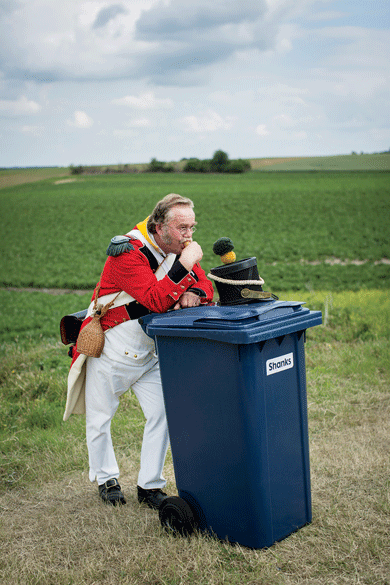You would never have something of this scale in the United States,” says Kathryn Rosewitz, originally from Missouri but now living in Germany. “Like, it would not happen.” Kathryn and her sister, Emily, are dressed as upper-class ladies from nineteenth-century Brussels. Kathryn is wearing a bonnet primped with a bloodred feather and spilling a Jane Austen–ish quantity of strawberry-blond ringlets. Emily’s Empire dress has a lacy neckline and is cinched at the waist with a sort of shawl-cum-belt, as if she’s being hugged from behind by a bedspread. Kathryn in particular has a knack for slipping archaisms into her speech without ever sounding less than a hundred percent twenty-first-century late-teen American. On Wednesday, she and Emily attended the Duchess of Richmond’s ball at the Château Sainte-Anne, in Brussels. “It was a lot of fun,” she says. “The Duke of Wellington showed up.” Too bad he had to retire early with his advisers, but his manners were impeccable. “He bade the rest of us to continue our dancing and complete the evening.”
The risk with an event like Waterloo 2015, the four-day bicentennial celebration on the site of the Battle of Waterloo, in present-day Belgium, is that its scale acts less as an acknowledgment of than a distraction from the horrors it purports to memorialize. Wellington’s final defeat of Napoleon, on June 18, 1815, occupies such a firm place in British self-identity, as the defining example of Anglo-Saxon pluck and stoicism in the face of continental tyranny, that it’s as well to remember how close the Allied armies came to losing, and at what appalling cost victory was won. By early evening Napoleon’s notoriously hotheaded Marshal Ney had captured the farmhouse at La Haie-Sainte and the French had all but prevailed; only the late intervention of the Prussians, under Field Marshal Blücher, swung the momentum back in the Allies’ favor. “I never took so much trouble about any Battle,” Wellington wrote later, “and never was so near being beat.”
Estimates of casualties range from 42,000 to 53,000. As Paul O’Keeffe points out in Waterloo: The Aftermath, however, the toll of death and suffering is less striking than its density. Roughly 92,000 had been killed or wounded at Leipzig in 1813. What gave Waterloo such grim distinction two years later was the confinement of its combatants to a site measuring only five square miles. (The front at Leipzig was twenty-one miles long.) Per-square-mile British casualties were almost ten times higher than at the first Battle of the Somme. Parts of the field were so densely carpeted in corpses that it was impossible to avoid walking over them. Wellington refused to glory in such slaughter. “Next to a battle lost,” he reputedly said, “the greatest misery is a battle gained.”
The numbers attending the commemorations are certainly impressive. Eleven thousand five hundred people come to see Inferno, Thursday night’s prefatory son et lumière. (Imagine the opening ceremony of a Belgian Olympics and you’ll get a fair idea.) Friday and Saturday nights will bring the two battle reenactments, The French Attack and The Allied Counterattack, which will each attract 60,000 paying customers, plus 7,000 VIPs from the event’s corporate sponsors, including Renault, Paris Match, and a local brewery hawking Waterloo, “The Beer of Bravery!” (After my four days in Belgium I will conclude that the decidedly Bud-like Jupiler is more my bag, beer-wise. Jupiler’s slogan is “Les hommes savent pourquoi” — “Guys know why.” I certainly do: it doesn’t let anything as irrelevant as flavor get in the way of drinking.) More than 5,000 battle reenactors, accompanied by 1,000 camp followers — i.e., women, children, and veteran reenactors too old or infirm to handle the musket fire — have converged on the site from fifty countries. To put that in perspective: roughly 180,000 men were engaged in the actual battle. Even among reenactments, the troops massed at Waterloo 2015 are dwarfed by the 17,000 Soviet soldiers, reportedly paid a dollar a day, who appeared in Sergei Bondarchuk’s epic, and epically stodgy, movie Waterloo (1970). (It’s been said that during production Bondarchuk had the world’s seventh-largest army under his command.) Still, as live events go, five thousand plus is major-league.
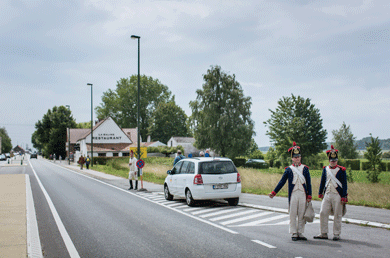 A long-standing controversy attaching to such events has to do with the degree of immersion in period. In Confederates in the Attic, his ten-state inquiry into the ongoing legacy of the Civil War, Tony Horwitz distinguishes between “farbs,” fair-weather reenactors who wear wristwatches or insect repellent, and “hardcores,” who, in pursuit of the “period rush” of maximum authenticity, adhere to mid-nineteenth-century speech patterns and starve themselves to achieve “the gaunt, hollow-eyed look of underfed Confederates.” (The derivation of farb may be “far be it from authentic”: no one is quite sure.)
A long-standing controversy attaching to such events has to do with the degree of immersion in period. In Confederates in the Attic, his ten-state inquiry into the ongoing legacy of the Civil War, Tony Horwitz distinguishes between “farbs,” fair-weather reenactors who wear wristwatches or insect repellent, and “hardcores,” who, in pursuit of the “period rush” of maximum authenticity, adhere to mid-nineteenth-century speech patterns and starve themselves to achieve “the gaunt, hollow-eyed look of underfed Confederates.” (The derivation of farb may be “far be it from authentic”: no one is quite sure.)
There’s little love lost between the two factions. A month before traveling to Belgium I had lunch with Mark Wallis, the founder of Past Pleasures, a historical-interpretation company based in Surrey, England. Wallis was part of the team that would ferry the New Waterloo Dispatch, a carefully worded declaration of pro-E.U. sentiment, from Belgium to London by post chaise and Royal Navy frigate. The journey was scheduled to take three days, in keeping with the delay an anxious British public had to endure for Wellington’s original victory dispatch, on which the N.W.D., handsomely printed on foam mounting board, was very loosely based. Wallis and I were sitting in a Kansas City–style barbecue joint near the Tower of London, where his team parleyed with the public, in character. For hardcores, meanwhile, history is less an interest than a hideaway. “These men — because they are men — so much want to live in the past, they actually want to have rickets, have loose teeth in their gums,” Wallis said. “They sleep in ditches and get rained on — ‘Ooh, I’m really ill, this is great.’ They are complete fruitcakes. . . . And that’s not me. I like to stay in a bed-and-breakfast or hotel. As Laurence Olivier said, ‘Try acting, dear.’ ”
Quite where the majority of Waterloo reenactors sit on the farb-hardcore spectrum is tricky to judge. In part this is a simple function of diversity. Unlike, say, English Civil War reenactment, which largely falls under the aegis of centralized organizations like the Sealed Knot, Napoleonic reenactment tends to devolve to a mass of smaller, independent regiments that you really have to hand it to the Waterloo organizers for marshaling. At the Hougoumont bivouac, I’m given a tour of Allied living conditions by Alain Habils. Habils is a heavyset fireman who is seemingly liked by everybody. Normally he would be taking part in the reenactments, as a surgeon for the Dutch-Belgian 7th Line Infantry, but given the scale of this year’s event he has sacrificed his place on the field to help with logistics. “Someone’s got to do it,” he says, likably. In this he is assisted by Ron Van Dyck, a nervy character in period fatigues, who has the kind of saddle-grade tan that could well have come from sleeping, or indeed living, in a ditch: he looks like he’s never been indoors, and is by a long shot the most authentic-looking historical person I will see all weekend. Every so often Van Dyck materializes with the pop-eyed look of a time traveler who has yet to adjust to cell-phone technology or people in reasonable health past the age of thirty.
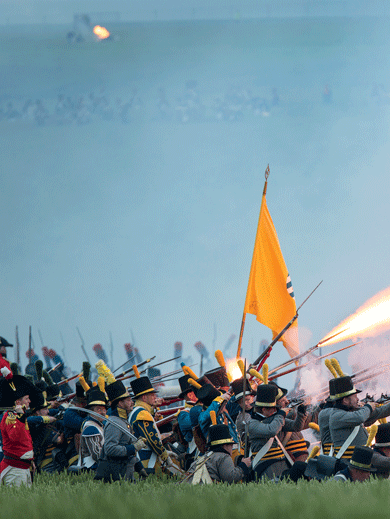 I follow Habils into the British encampment, housed inside the perimeter wall of the Château d’Hougoumont, where, in 1815, fewer than 3,000 Allied soldiers resisted wave after wave of merciless attack by as many as 13,000 French. Campfires crackle outside rudimentary canvas tents — although, as Habils points out, if not quite in these terms, proper shelter is toward the farby end of hardcore. Much of Wellington’s army spent the night before Waterloo out in the open during a torrential rainstorm. Everyone here looks dry and clean and well slept, the odd readily legible hangover notwithstanding. The sun is emerging victorious from a skirmish with a rain cloud. A surgeon with the 23rd Royal Welch Fusiliers interrupts his grisly demonstration of early-nineteenth-century surgical techniques to offer a small boy a two-for-one deal on amputations. The kid squirms with delight. Under a fly tent opposite, a blackboard reads, “Next amputation 2.30 SHARP.” Redcoats pose for photographs with grinning visitors. The general atmosphere recalls a craft fair on the grounds of an insolvent stately home.
I follow Habils into the British encampment, housed inside the perimeter wall of the Château d’Hougoumont, where, in 1815, fewer than 3,000 Allied soldiers resisted wave after wave of merciless attack by as many as 13,000 French. Campfires crackle outside rudimentary canvas tents — although, as Habils points out, if not quite in these terms, proper shelter is toward the farby end of hardcore. Much of Wellington’s army spent the night before Waterloo out in the open during a torrential rainstorm. Everyone here looks dry and clean and well slept, the odd readily legible hangover notwithstanding. The sun is emerging victorious from a skirmish with a rain cloud. A surgeon with the 23rd Royal Welch Fusiliers interrupts his grisly demonstration of early-nineteenth-century surgical techniques to offer a small boy a two-for-one deal on amputations. The kid squirms with delight. Under a fly tent opposite, a blackboard reads, “Next amputation 2.30 SHARP.” Redcoats pose for photographs with grinning visitors. The general atmosphere recalls a craft fair on the grounds of an insolvent stately home.
In the handily situated (and über-farby) Wi-Fi tent, I talk to Matthew Viggers, who is reenacting the role of a sergeant from the 2nd Battalion Coldstream Guards. Nearby, a group of fit-looking guys in cream-and-blue fatigues impart an air of jovial menace. They won’t talk to me. This is because they are actual British soldiers, seconded to the historical simulation of their own regiment, and the Ministry of Defence has embargoed any contact with the media. Viggers, by contrast, is only too happy to chat. He sports a pair of dashing rotter’s sideburns on an irredeemably kindly face. Aside from its historical interest, reenactment holds for Viggers the appeal of belonging, the esprit de corps of the young squaddies lolling in the grass a few feet to our left. “Although we’re only portraying a military unit, so obviously there are certain experiences we’ll never have, you do start to bond as a group.”
“In a way that might be similar to serving in the real army?” I asked.
“I like to think so, yes.”
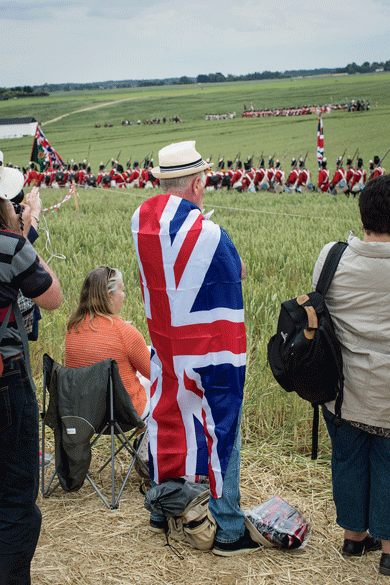 Nicky Butland, a historical dressmaker from Cornwall, England, agrees. She’s here both as a camp follower and as a (male) gunner in the Royal Horse Artillery. “I remember people when I was little talking about the Second World War. On the one hand they’d seen things they never want to see again . . . but on the other hand, the camaraderie, the good times they had, were amazing.” For many here, reenactment offers something comparable. Testament to this are the lengths to which some will go not to quit. Habils tells me that an average of fifteen people a day have been evacuated from the site by ambulance. Later, I hear that a Canadian reenactor suffered a fatal heart attack. “These events are not easy,” Butland explains. She worries for some of the veteran reenactors. “A lot of older people, or people who are less well, have extended their reenacting career far beyond their health to do this event. . . . Sometimes the will is there but the body isn’t happy to do it.”
Nicky Butland, a historical dressmaker from Cornwall, England, agrees. She’s here both as a camp follower and as a (male) gunner in the Royal Horse Artillery. “I remember people when I was little talking about the Second World War. On the one hand they’d seen things they never want to see again . . . but on the other hand, the camaraderie, the good times they had, were amazing.” For many here, reenactment offers something comparable. Testament to this are the lengths to which some will go not to quit. Habils tells me that an average of fifteen people a day have been evacuated from the site by ambulance. Later, I hear that a Canadian reenactor suffered a fatal heart attack. “These events are not easy,” Butland explains. She worries for some of the veteran reenactors. “A lot of older people, or people who are less well, have extended their reenacting career far beyond their health to do this event. . . . Sometimes the will is there but the body isn’t happy to do it.”
On my way out of the bivouac I meet Peter Catley, a Falstaffian figure perched on a foldout chair and wearing the scarlet coat and tricorn hat of a Chelsea pensioner circa 1810. A few years ago health concerns forced him to retire from active reenactment with the 9th Regiment of Foot. What keeps him coming to these events?
“Well, I’d be awfully tempted to tell you to look around and see,” he says, gesturing at the squad of redcoats gathered at a low iron grill. “It’s here. This is it. This is as good as it gets.”
Not long after joining the queue for The French Attack, I begin to record expletives on my Dictaphone. This is not only to let off steam but to record, in the name of due journalistic diligence, precisely how dicked-off I’m getting. The extra Jupiler I had at lunchtime has left me tired and grouchy. (Jupiler: The Beer of Same-Day Hangover!) What’s more, the burger I bought for supper was so unfit for human consumption that I took only one bite before adding it to the circumambient overspill of a garbage can that proper project management might have predicted would be full by Friday evening. Still, dehydration/hypoglycemia aside, the queue for the reenactment is ridiculous. For reasons of their own, the police have cordoned off the Chaussée de Charleroi, so 60,000 punters are being extruded through entry points designed for half that number. Scandalized French-speaking men are doing their gestural best. Mais c’est vraiment ab-surde! C’est danger-eux! The police exercise their right to weary indifference. Halve the average age and waist measurement and you might feel a little like you were lining up to get into a major outdoor rock concert in London, were it not for the fact, I can’t help thinking — borderline xenophobic though the thought may be — that compared with these supposedly brisk and hyperefficient continentals, we in chaotic, deregulated, heartlessly neoliberal Britain simply run things better.
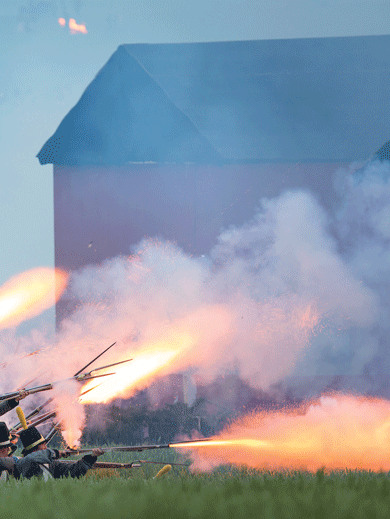 I’m not alone in this feeling. Six weeks to the day before the Waterloo bicentennial, an unexpected Conservative majority in the U.K. general election made a referendum on Britain’s E.U. membership a racing certainty. David Cameron, the prime minister, had, of course, pledged to campaign for Britain to stay in. But the pressure from Euroskeptic backbenchers to renegotiate the terms of the country’s membership in the E.U, plus the 12.6 percent of the vote won by the radical-right U.K. Independence Party (UKIP), which is dedicated to freeing the U.K. from the shackles of unaccountable Euro-bureaucracy, had caught a mood of disillusion that was only entrenched by the economic catastrophe closing in on Greece. A few weeks after the election I met with Michiel van Hulten, a Dutch policy consultant and former member of the European Parliament who is now living in La Hulpe, a village between Waterloo and Brussels. On balance he felt that a U.K. exit was more likely than not: “I don’t see how you can maintain a unified E.U. structure, and get everything done the way the euro zone wants to get done, and still keep countries like the U.K. on board.”
I’m not alone in this feeling. Six weeks to the day before the Waterloo bicentennial, an unexpected Conservative majority in the U.K. general election made a referendum on Britain’s E.U. membership a racing certainty. David Cameron, the prime minister, had, of course, pledged to campaign for Britain to stay in. But the pressure from Euroskeptic backbenchers to renegotiate the terms of the country’s membership in the E.U, plus the 12.6 percent of the vote won by the radical-right U.K. Independence Party (UKIP), which is dedicated to freeing the U.K. from the shackles of unaccountable Euro-bureaucracy, had caught a mood of disillusion that was only entrenched by the economic catastrophe closing in on Greece. A few weeks after the election I met with Michiel van Hulten, a Dutch policy consultant and former member of the European Parliament who is now living in La Hulpe, a village between Waterloo and Brussels. On balance he felt that a U.K. exit was more likely than not: “I don’t see how you can maintain a unified E.U. structure, and get everything done the way the euro zone wants to get done, and still keep countries like the U.K. on board.”
At Waterloo 2015, it’s hard to detect much concern for the crumbling of the European project, a project that the event is, tangentially at least, intended to celebrate. During the press briefing for Inferno, on Thursday evening, I asked its director, Luc Petit, whether the show was a reflection on the relevance of Waterloo to contemporary European politics. There followed the sort of dilating silence you get on learn-a-language CDs when it’s your turn to supply the phrase. Amiable Annemie Verschueren, from the presiding P.R. outfit, inserted herself to reminisce about the morning’s official ceremony, attended by the king and queen of Belgium and involving the planting of flags and a round of symbolic handshakes among the no-longer-inimical descendants of those who’d fought at Waterloo, along with other cautious pledges of European unity and regret. “A kind of Schengen,” said another of the organizers, and everyone laughed, mirthlessly.
The moment I catch my first glimpse of soldiers massing on the ridge, the wait seems worth it. Earlier, Fritz Bronner, an L.A.-based actor and producer who is here as a cavalry officer in the Royal Scots Greys, the regiment famous for charging d’Erlon’s infantry corps and capturing an imperial eagle, spoke about the fleeting access to the past that reenactments can offer, a kind of wormhole effect gone in an instant but entrancing while it lasts. “Everyone there in these moments will have a flash and forget for a moment. Even if it’s just a second — it will look as close as it ever looked.”
That afternoon I join the scrum of sharp-elbowed reporters waiting to interview Napoleon. He is forty-five minutes late. When I interviewed the (cheerful, Kiwi) guy playing Wellington, the atmosphere was jokey and knowing; he asked me, in character (bar the New Zealand accent), whether Harper’s Magazine can arrange “an accident” to befall Gonzague Vandamme, the French TV journalist standing next in line.
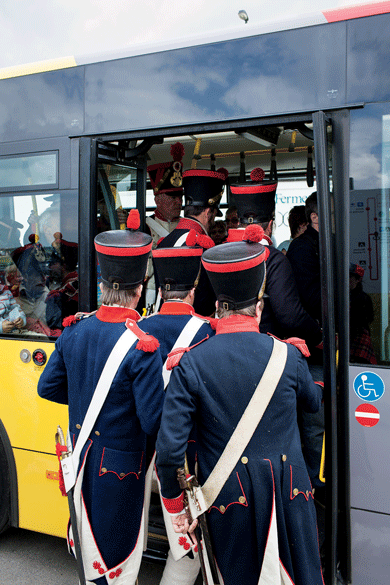 No such campery at the emperor’s tent. An aide-de-camp suffers a serious sense-of-humor failure when a photographer edges too close to the imperial trestle table. “Reculez!” Stand back! Then a shout goes up — “Vive l’Empereur!” — and the generals stand to attention. The reputation of Frank Samson, the forty-seven-year-old lawyer from Orléans who is playing Napoleon, precedes him for several reasons. First, there’s been a tussle for the top job in Napoleonic reenactment since 2003, when ill health forced the reigning Italian impersonator to abdicate. Mark Schneider, from Williamsburg, Virginia — arguably the birthplace of the modern living-history movement — is said to bear a stronger resemblance, and played a blinder at the Jena bicentennial in 2006. For political reasons, however — or so I hear — the Waterloo gig has gone to the Frenchman. In 2011 Samson was crowned emperor at the Basilica of Notre Dame in Boulogne. Now, he flicks out his coattails and sits. With his brushed-forward hairpiece Samson reminds me a little of Joe Pesci, a little of M. Homais in Madame Bovary. The sense he might stab you in the eye, then write a pedantic little treatise about it. A German reporter asks Samson whether being a lawyer in real life has any bearing on his portrayal of Napoleon.
No such campery at the emperor’s tent. An aide-de-camp suffers a serious sense-of-humor failure when a photographer edges too close to the imperial trestle table. “Reculez!” Stand back! Then a shout goes up — “Vive l’Empereur!” — and the generals stand to attention. The reputation of Frank Samson, the forty-seven-year-old lawyer from Orléans who is playing Napoleon, precedes him for several reasons. First, there’s been a tussle for the top job in Napoleonic reenactment since 2003, when ill health forced the reigning Italian impersonator to abdicate. Mark Schneider, from Williamsburg, Virginia — arguably the birthplace of the modern living-history movement — is said to bear a stronger resemblance, and played a blinder at the Jena bicentennial in 2006. For political reasons, however — or so I hear — the Waterloo gig has gone to the Frenchman. In 2011 Samson was crowned emperor at the Basilica of Notre Dame in Boulogne. Now, he flicks out his coattails and sits. With his brushed-forward hairpiece Samson reminds me a little of Joe Pesci, a little of M. Homais in Madame Bovary. The sense he might stab you in the eye, then write a pedantic little treatise about it. A German reporter asks Samson whether being a lawyer in real life has any bearing on his portrayal of Napoleon.
“Ah non,” says Samson. “C’est une erreur. Je suis le vrai.”
It’s a fair gag, under the circumstances. I’m the real Napoleon. What makes M. Samson such an (a) formidable reenactor and (b) possibly genius-level comedian is his ability to appear both alert to the absurdity of his calling and determined not to let that alertness detract from its gravity — either, you get the sense, out of a proper respect for his audience and their wish not to have the make-believe disrupted by an excess of self-consciousness, or, maybe, because there’s a part of M. Samson that would like to be the real Napoleon, or at least to think that it’s okay to want to be. Last night, the Belgian daily Le Soir uploaded a picture of Samson in full regalia remonstrating with police after they threatened to impound a car belonging to one of his generals. The body language was “I don’t care if it’s a parking violation. You don’t impound my general’s car.” Over my four days wandering among the encampments, there are moments, rare but memorable, when I find it genuinely hard to tell whether reenactor X or Y is behaving pompously/humorlessly/bossily because that’s the only way to maintain the fiction we’re all here to enjoy, or whether they’re taking advantage, as many of us would, of the rare official sanction to be self-important.
Back in the stands that border the battlefield, I find myself trying to reenter that fiction, to slip back through the wormhole in order to experience, again, the empathetic thrill, akin to alarm, that I felt earlier. Each reenactment consists not so much in a stage of the battle as a two-hour précis of one thrust of it. Tomorrow, the Allies strike back. I settle in my tip-up seat and attempt to regress 200 years (plus one day).
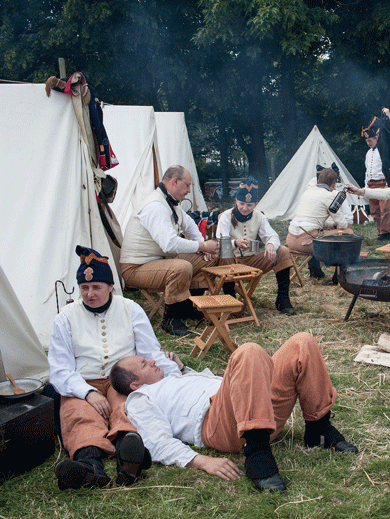 A few factors conspire against me. One is the music. Shortly after the artillery of the King’s German Legion begins pounding the French positions, what seem to be mammoth concert-level line arrays let rip with “O Fortuna,” from Carmina Burana, a choice so mind-bendingly unoriginal that I start to worry it’s a cliché to find it a cliché. In any case, the imposition of a soundtrack only cinematizes the spectacle, makes it unreal, when what had been really striking was watching the French, under Marshal Ney, march in force down the hill toward Wellington’s first line, with no sound between the cannonades and bursts of musket fire but the wind in the waist-high crops. The accompanying commentary, delivered alternately in French and Flemish, has a similar Verfremdungseffekt, and for English speakers it lacks the compensating benefit of explaining which regiment is doing what to whom and why. (Earlier I had impressed myself by interviewing a hussard from the 2ème Régiment in passable French. Now, drifting in but mostly out of comprehension, I experience something that might be peculiar to the Anglo experience of non-Anglophone Europe: a form of monoglot self-loathing, a lingua-hegemonic guilt expressed as indignation that translation into English is not provided as a matter of course.)
A few factors conspire against me. One is the music. Shortly after the artillery of the King’s German Legion begins pounding the French positions, what seem to be mammoth concert-level line arrays let rip with “O Fortuna,” from Carmina Burana, a choice so mind-bendingly unoriginal that I start to worry it’s a cliché to find it a cliché. In any case, the imposition of a soundtrack only cinematizes the spectacle, makes it unreal, when what had been really striking was watching the French, under Marshal Ney, march in force down the hill toward Wellington’s first line, with no sound between the cannonades and bursts of musket fire but the wind in the waist-high crops. The accompanying commentary, delivered alternately in French and Flemish, has a similar Verfremdungseffekt, and for English speakers it lacks the compensating benefit of explaining which regiment is doing what to whom and why. (Earlier I had impressed myself by interviewing a hussard from the 2ème Régiment in passable French. Now, drifting in but mostly out of comprehension, I experience something that might be peculiar to the Anglo experience of non-Anglophone Europe: a form of monoglot self-loathing, a lingua-hegemonic guilt expressed as indignation that translation into English is not provided as a matter of course.)
What’s interesting is how close the best aspects of the reenactment come to depictions of war that subordinate pathos to tactics. Where J.M.W. Turner’s The Field of Waterloo, for example, bears comparison to the kind of medium shot the director of a war movie might use to evoke a battle’s human consequences, the reenactment is most affecting in long shot, the sort of panoptic perspective you get in Pieter Snayers’s Battle of Kircholm or in Bondarchuk’s aerial sequences. Up close, things can get a little lame. The press zone has a plum view of Hougoumont, or rather the scaled-down plywood playhouse representing it. Just as The French Attack is compressed in time, so is it compressed in space, and it’s disorienting to watch the infantry besiege a stage set when the real château lies just a mile to the southwest. About an hour in, a soldier of the 1èr Légère, or some such, breaks into the farmyard — and here we might travel back two hundred years, one day, and roughly nine hours, and imagine the scene inside the actual Château d’Hougoumont, where scores of French infantry were engaged in hand-to-hand combat with the defending Scots Guards — and pulls a plywood panel off the wall, exposing the lumber frame underneath. When I spoke to Ian Bailey, a Sealed Knot director and a seasoned Roundhead, at an event in Leicestershire a few weeks before Waterloo 2015, he emphasized the “rufty-tufty” nature of Dark Ages reenactment. Given advances in weapons technology, he said, the later in history you go, the more reenactment resembles “just firing a gun.” “The English Civil War is about as far as you can go where it’s still what you can roughly call contact sport.”
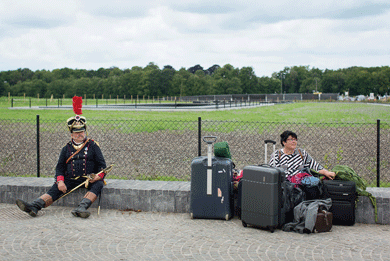 At Waterloo, the troop movements and fusillades of musket fire — ragged orange gashes in the smoke — are thrilling to watch at a distance. Closer in, the ranks of enemy infantry engage with all the murderous intensity of a round of patty-cake. It’s nine-fifteen and getting cold. There are forty-five minutes to go but the bleachers are emptying. Maybe it’s just me, but the battle does seem to be withdrawing into itself, drawing a veil over itself, as the smoke from the cannons and muskets and campfires gets denser, and the reenactors become both less visible and less aware of their surroundings, lost, you imagine, in their trance of smoke and black-powder stink and authentically uncomfortable uniforms, stuck Alice-like down the rabbit hole with no apparent intention of coming back.
At Waterloo, the troop movements and fusillades of musket fire — ragged orange gashes in the smoke — are thrilling to watch at a distance. Closer in, the ranks of enemy infantry engage with all the murderous intensity of a round of patty-cake. It’s nine-fifteen and getting cold. There are forty-five minutes to go but the bleachers are emptying. Maybe it’s just me, but the battle does seem to be withdrawing into itself, drawing a veil over itself, as the smoke from the cannons and muskets and campfires gets denser, and the reenactors become both less visible and less aware of their surroundings, lost, you imagine, in their trance of smoke and black-powder stink and authentically uncomfortable uniforms, stuck Alice-like down the rabbit hole with no apparent intention of coming back.
For the Brits it’s all about the second reenactment. Most of the visitors I speak to on Saturday tell me that they skipped Friday evening; they came to the bicentennial exclusively for The Allied Counterattack. The notion that Waterloo was a predominantly British victory and a testament to national character has proved strikingly resilient. In his original dispatch Wellington took pains to share the credit with Britain’s main ally, albeit in rather pinched terms: “I should not do justice to my own feelings, or to Marshal Blücher and the Prussian army, if I did not attribute the successful result of this arduous day to the cordial and timely assistance I received from them.” As the historian Alan Forrest notes, however, this “was virtually the last time” Wellington mentioned them; by the time William Siborne had designed the official scale model of the battle, Wellington made sure the Prussian involvement was greatly diminished. For generations of visitors — travel guides to the battlefield were being published before 1815 was out — Waterloo has stood as a paradigm of British noncompliance, brave contrariness, bloody-minded refusal to yield to continental coercion.
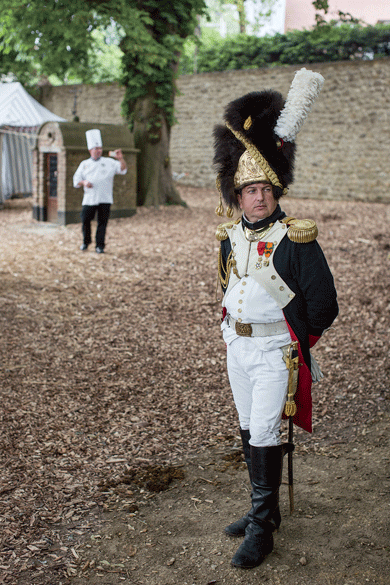 “I see Brussels having similar objectives to Bonaparte,” says Nigel Farage, the leader of UKIP, when I speak to him a week after the bicentennial. “The wish for a United States of Europe.” I had missed Farage at Waterloo, perhaps because he avoided the reenactments and “official bilge” of the opening ceremony in favor of a whistle-stop tour of the bivouacs and Napoleon’s HQ, where Frank Samson presented him with a replica of a five-franc coin from 1812 and opined that the old currency was better than the euro. “So I conclude that the modern-day Napoleon is actually a Euroskeptic,” Farage said, “which I’m quite pleased with.”
“I see Brussels having similar objectives to Bonaparte,” says Nigel Farage, the leader of UKIP, when I speak to him a week after the bicentennial. “The wish for a United States of Europe.” I had missed Farage at Waterloo, perhaps because he avoided the reenactments and “official bilge” of the opening ceremony in favor of a whistle-stop tour of the bivouacs and Napoleon’s HQ, where Frank Samson presented him with a replica of a five-franc coin from 1812 and opined that the old currency was better than the euro. “So I conclude that the modern-day Napoleon is actually a Euroskeptic,” Farage said, “which I’m quite pleased with.”
Michiel van Hulten, the Dutch policy consultant, finds Farage’s exceptionalist “arrogance” familiar. “There is a view that the U.K. considers that somehow it’s more important than other member states. . . . At some point you’ve got to accept that you’re a member of the club.” However much victory at Waterloo can be credited to the Brits, the final struggle against Napoleon galvanized the major European powers to act in concert and heralded ninety-nine years of relative peace and prosperity on the Continent. For Farage, the united front shown by the British, the Prussians, the Dutch, and other members of the Seventh Coalition demonstrates the need for “cooperation between independent, separate groups of people, not assimilation under one flag, one anthem, one army, and one leader.” Sitting in the bleachers above the battlefield, however, imagining the carpet of corpses where the wheat now grows, let alone the tens of millions killed between 1914 and 1945, the Euroskeptic argument seems suddenly vulnerable to charges of quietism, of an unwarranted confidence that the seventy years of stability since V-E Day — underwritten, for all their inadequacies, by the institutions of European unity — will not meet an end more abrupt than the one we prosperous, amnesiac postwar Europeans have come to expect.
By eight on Saturday evening the bleachers are full and the Allies are itching to reverse the previous evening’s setbacks. The consensus about The French Attack is that while large parts of the audience were unhappy (because of the cold, the smoke, the lack of English commentary), the reenactors had a blast. Fritz Bronner is rhapsodic. “It was the most epic, extreme riding experience,” he tells me. “Galloping in formation in the three-foot-high wheat, on the historic rolling hills, down into the valley toward the French, was a maddening, chilling rush of euphoric senses. Those gray Hungarian Lipizzaner horses we rode — they were our legs and they were magnificent steeds!” Word at the two o’clock press briefing was that last night’s French commentator has been fired for having a boring voice and getting some facts wrong about Blücher. Tonight we are promised a new, zippier, factually accurate voice-over, plus translation into English.
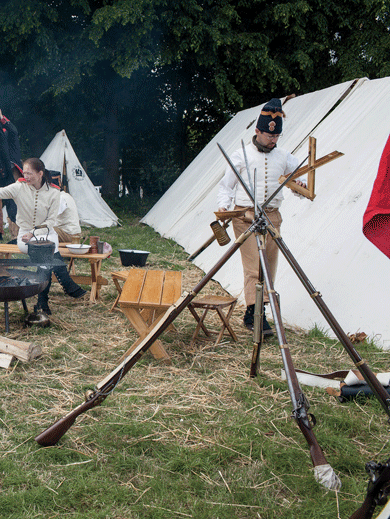 From my perspective, high up in the bleachers, one benefit of the smoke is that it relieves you of the effort of extrapolation: you can no longer see how sparsely the battlefield is populated. The drawback is that you frequently can’t see anything at all. From somewhere in the murk a fifer leads an invisible infantry battalion. Then a westerly will blow a clearing and grant a glimpse. The 3rd and 5th Cuirassiers mount a charge above La Haie-Sainte. Brunswickers arrive in black dolmans and shakos. Above the tree line, a hot-air balloon hangs sheepishly, like a passerby embarrassed to have walked into the shot. In London, Parliament Square is clearing after 250,000 people rallied to protest the government’s austerity measures. Nearer Hougoumont, Wellington gallops past on Copenhagen, his cocked hat in the air. Greece has ten days to repay 1.5 billion euros to the International Monetary Fund or become the first developed country ever to fall into arrears. Three days later, risk consultants warn that escalating borrowing costs mean that Portugal will be next if Greece exits the euro. In the distance, from the ridge above La Haie-Sainte, the French Imperial Guard begins its final, fated attack, and it’s thrilling again, this spectacle, transporting, hallucinatory. Then the smoke closes in, the battle slips back into the past, and all you can hear is the gunfire.
From my perspective, high up in the bleachers, one benefit of the smoke is that it relieves you of the effort of extrapolation: you can no longer see how sparsely the battlefield is populated. The drawback is that you frequently can’t see anything at all. From somewhere in the murk a fifer leads an invisible infantry battalion. Then a westerly will blow a clearing and grant a glimpse. The 3rd and 5th Cuirassiers mount a charge above La Haie-Sainte. Brunswickers arrive in black dolmans and shakos. Above the tree line, a hot-air balloon hangs sheepishly, like a passerby embarrassed to have walked into the shot. In London, Parliament Square is clearing after 250,000 people rallied to protest the government’s austerity measures. Nearer Hougoumont, Wellington gallops past on Copenhagen, his cocked hat in the air. Greece has ten days to repay 1.5 billion euros to the International Monetary Fund or become the first developed country ever to fall into arrears. Three days later, risk consultants warn that escalating borrowing costs mean that Portugal will be next if Greece exits the euro. In the distance, from the ridge above La Haie-Sainte, the French Imperial Guard begins its final, fated attack, and it’s thrilling again, this spectacle, transporting, hallucinatory. Then the smoke closes in, the battle slips back into the past, and all you can hear is the gunfire.

